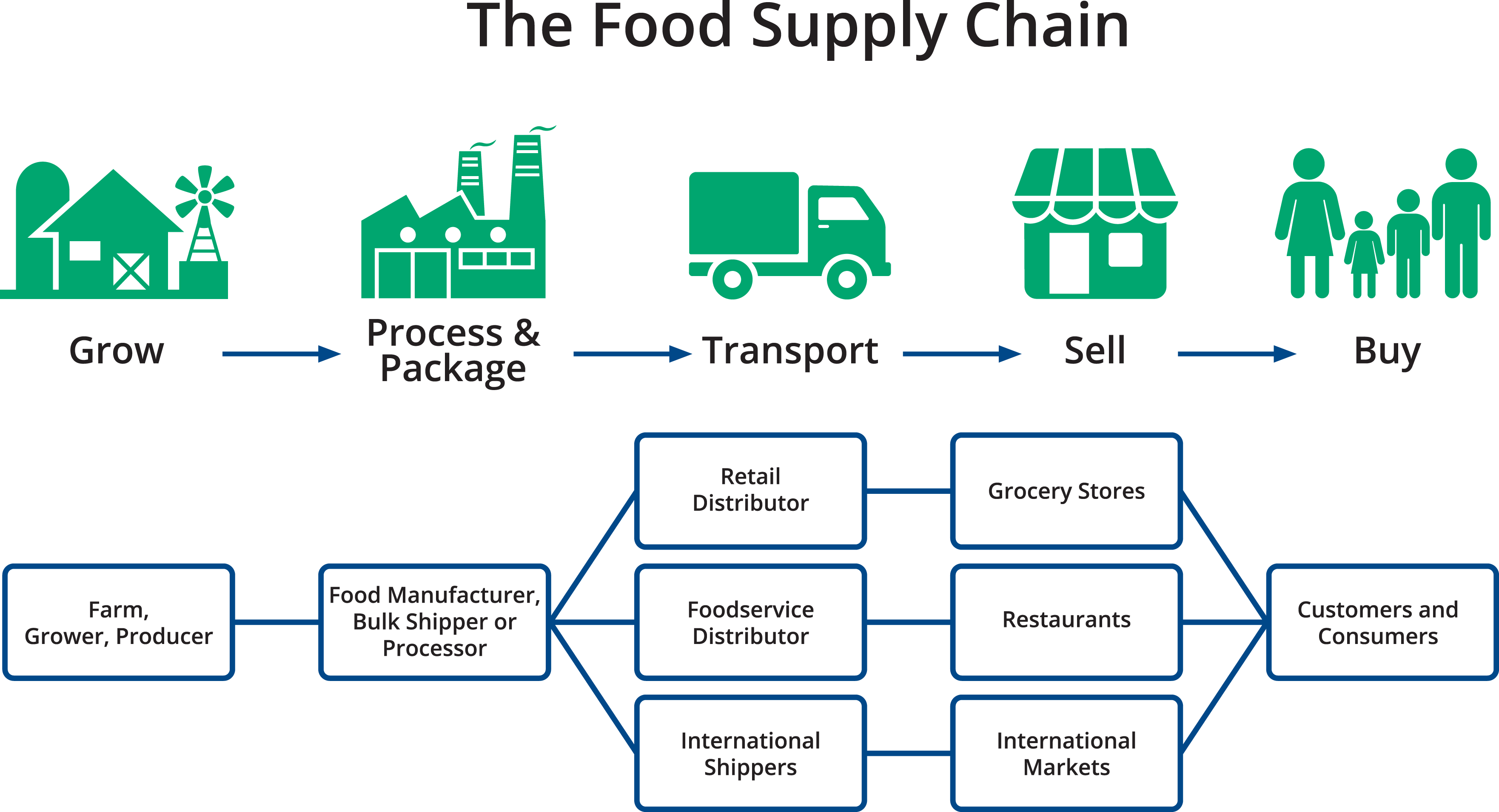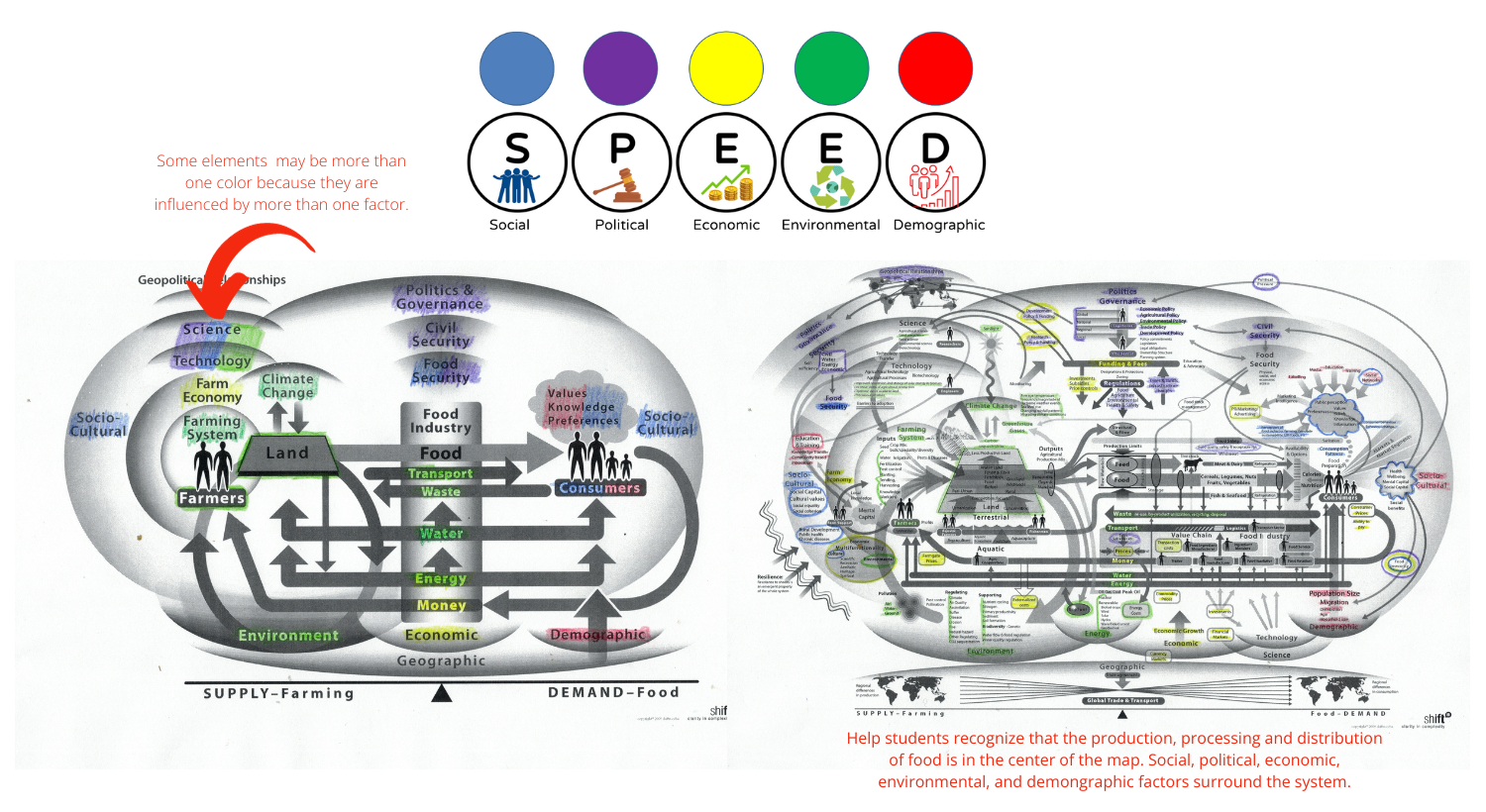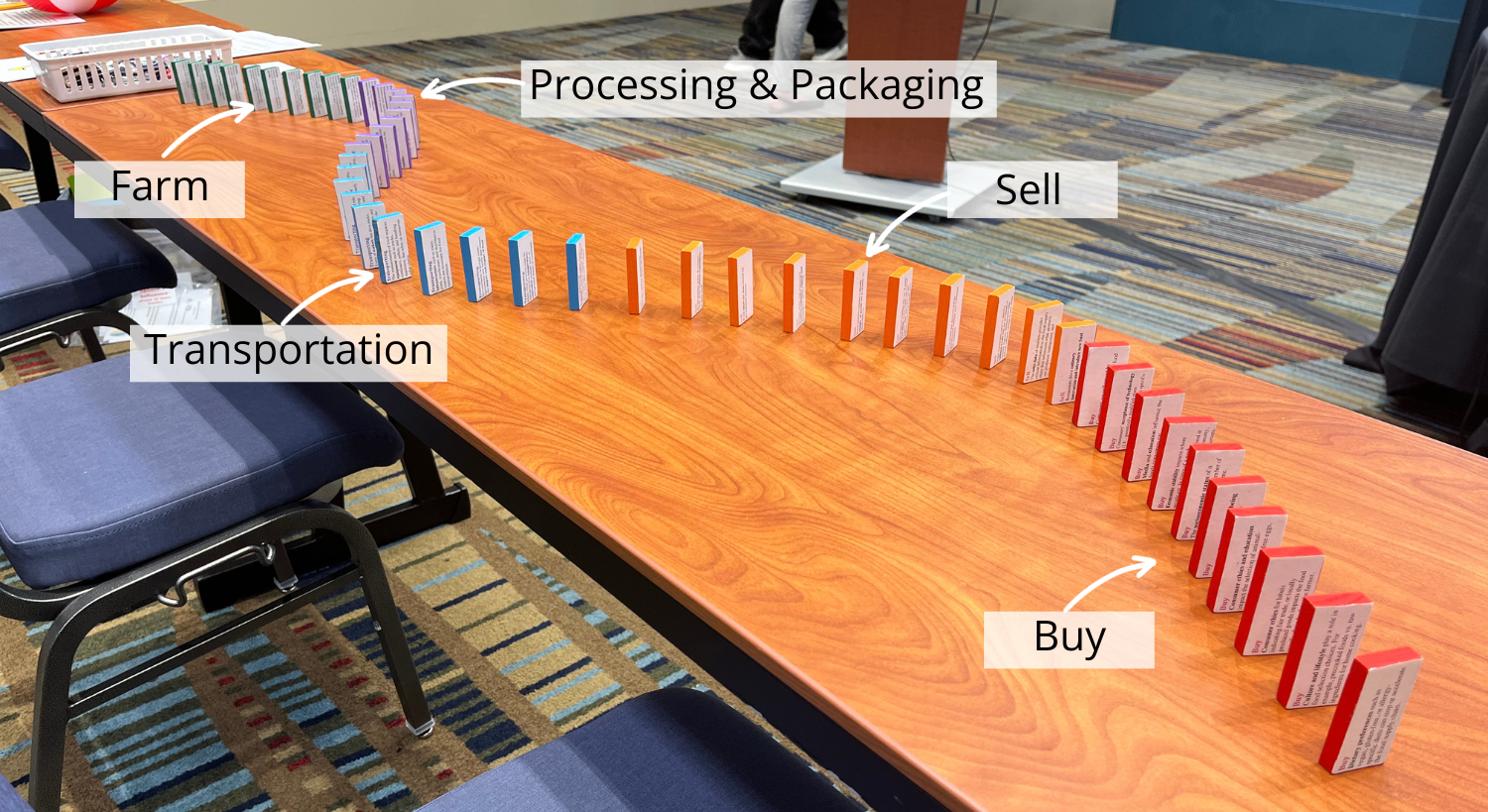Agricultural Literacy Curriculum Matrix
Lesson Plan
Tracing the Agricultural Supply Chain
Grade Level
Purpose
Explore the complexity of global commodity chains that link the production and consumption of agricultural products. Discover how economics, politics, infrastructure, and other conditions affect the distribution of food throughout the world.
Estimated Time
Materials Needed
Engage:
Activity 1: The Food Supply Chain
- Tracing the Agricultural Supply Chain slide deck
- Save your own copy of this slide deck.
- Tracing the Food Supply Chain handout, one (1) copy per student
Activity 2: Complexities of the Food Supply Chain
- Tracing the Agricultural Supply Chain slide deck (continued)
- Tracing the Food Supply Chain handout (continued)
- Food System Maps, one (1) copy per student printed in black and white. Print pages one (1) and two (2) only.
- Colored pencils, highlighters, or crayons in five (5) colors
Activity 3: What breaks the food supply chain?
- Breaking the Food Supply Chain cards, one (1) copy per class printed front to back
- Food Supply Chain Dominoes*
- Domino blocks (colored wooden blocks work best)
- Food Supply Chain Domino Descriptions, 1 copy per class printed on return address labels
*The Food Supply Chain Dominoes can be purchased from agclassroomstore.com.

Vocabulary
distributor: a company that provides food and non-food products to restaurants, cafeterias, caterers, and grocery stores
food processing: the process of transforming raw agricultural products, like grains, vegetables, meat, or milk, into end products to be sold to consumers
food supply chain: how food items travel from the farm (producer) to the consumer
value chain: the process or activities that add value to an item
Did You Know?
- Modern agricultural value chains grow and become more sophisticated as countries industrialize and strengthen their position in global markets.1
- The average grocery store in the United States carries over 39,500 different items.2
- Food production is a global corporate system. Food is imported and exported in large shipments across the world's oceans.4
- The U.S. imports about 20% of the food consumed.4
Background Agricultural Connections
The first step to understanding the farm-to-fork process of food involves a basic level of agricultural literacy—the food supply chain. Food is produced on a farm, processed and packaged, then distributed through grocery stores and restaurants where consumers purchase the food.
- Grow: Food is produced on farms and ranches located in all areas of the country and even around the world.
- Process and Package: The step where a food item is changed from its raw state on the farm to a finished state that is ready for retail consumers is called food processing. Examples include cutting, peeling, and packaging produce; changing milk into butter, cheese, ice cream and other dairy products; processing meat into retail cuts, wheat into bread, and much more.
- Transport: Semi trucks, planes, and cargo ships transport food from the processor to a retailer. Distributors handle the food between processing and selling. They provide a service to retail establishments by consolidating food from many different sources and bringing it all to one place for retailers to place their orders.
- Sell: Grocery stores, restaurants, and other retail and food service companies offer food for sale.
- Buy: Consumers purchase food in the form of groceries or a finished food product at a restaurant.
The food supply chain began being developed in early civilization with the transition from hunting and gathering to agriculture. Farmers grew crops and raised livestock and sold or traded what they didn't need at local markets. The food chain was very short and simple, selling products directly from farm to consumer. The food supply chain becomes more complex and sophisticated as countries industrialize and strengthen their position in global markets.
The complete food value chain is much more complex and provides insight when the food supply chain is interrupted. The value chain in agriculture identifies the set of factors and activities that bring a basic agricultural product from production in the field to final consumption. The terms "supply chain" and "value chain" are often used interchangeably.1 A complete value chain might include elements such as research and development to determine innovative processes, trends, consumer preferences, and inputs (e.g., seed, machinery, and other technologies) required within the food supply chain.
There are several factors or events that can disrupt or break the food supply chain. Some of the key factors include:
- Natural disasters such as hurricanes, floods, earthquakes, droughts, wildfires, and severe storms can damage agricultural lands, destroy crops, and disrupt transportation and distribution networks, leading to a food supply shortage.
- Outbreaks of pests, insects, or plant diseases can devastate crops, resulting in reduced yields or complete crop failures. This can lead to a scarcity of certain foods and impact the overall food supply.
- Climate change can have long-term effects on agricultural productivity. Changing weather patterns, increased frequency of extreme weather events, rising temperatures, and altered rainfall patterns can affect crop growth, livestock health, and the availability of water resources, ultimately disrupting the food supply chain.
- Political instability, conflicts, wars, civil unrest, and trade disputes can disrupt the production, distribution, and import/export of food. These situations can lead to disruptions in transportation, hinder access to markets, and result in food shortages and price spikes.
- Problems with transportation infrastructure, such as damaged roads, bridges, ports, or disruptions in the energy supply, can impede the movement of food from farms to markets, causing delays and shortages.
- Economic crises, market fluctuations, currency devaluations, inflation, and trade barriers can impact the affordability and availability of food. These factors can affect the purchasing power of consumers, disrupt supply chains, and lead to food insecurity.
- Public health emergencies such as epidemics, pandemics, or outbreaks of diseases (e.g., COVID-19) can disrupt the food supply chain by affecting the workforce availability, restricting movement and trade, and creating panic buying behaviors which can strain the distribution system.
- Failures or disruptions in critical technological systems such as irrigation systems, storage facilities, refrigeration units, or information systems can impact the efficiency and reliability of the food supply chain.
It's important to note that these factors can often interact with each other, amplifying their impacts and further complicating the resilience of the food supply chain. Governments, organizations, and stakeholders continuously work to mitigate and manage these risks to maintain a stable and sustainable food supply.
Engage
- Invite students to think back to 2020 when the pandemic began. Ask students to think in terms of food and ask what events they remember. If needed, provide prompts leading students to recall that restaurants and schools were closed (large food service areas), grocery stores had shortages (everyone needed to cook at home), etc.
- Watch, The Great Potato Giveaway. Ask students to watch for a single element that "broke" the food supply chain for this potato farmer during the pandemic.
- After students watch the video clip, ask them what single element disrupted the food supply chain. (Packaging. The farmer was set up to sell in bulk quantities to restaurants. When restaurants were closed he couldn't immediately pivot to retail packaging for grocery stores).
- Ask, "Does it seem silly that some plastic potato bags could shut down a whole food system? What other elements can compromise our food system?"
Explore and Explain
Activity 1: The Food Supply Chain
- Give each student one copy of the Tracing the Agricultural Supply Chain handout.
- Open the Tracing the Agricultural Supply Chain slide deck.
- Introduce the food supply chain (slide 3) by displaying the graphic and prompting students to trace some of the pathways illustrated in the diagram.

- Use slides 4-10 to illustrate examples of various food products and their path along the food supply chain.
- Using the bottom half of page 1 of their handout, have each student sketch a farm-to-fork diagram of foods. They should select a fruit or vegetable, a processed food (pizza, yogurt, donuts, sausage, etc.), and something they would buy in a restaurant.
- Optional: If you have more time, rather than a quick sketch, allocate each student a food commodity and assign them to make a detailed food supply chain graphic similar to the illustrations in the slide deck. The final product could be printed or digital according to your available supplies. Prompt students to look for pathways that pass through grocery stores, restaurants, and international markets (if applicable).
Activity 2: Complexities of the Food Supply Chain
- Using slide 12, discuss the question, "What adds complexity to the food supply chain?" Show the domino video and suggest that each domino is a factor that plays a role in the food supply chain.
- Watch The Incredible Logistics of Grocery Stores. As students watch the video clip, have them make a list of factors that make our modern food supply chain complex (page 2 of their handout). If time is short, only watch the first 2:35 and emphasize that one contributing factor to the complexity of our food supply chain is the fact that we have so many options in grocery stores.
- After the video, ask students what factors they identified and lead a class discussion on their reflections about the complexity of our food system.
- Give each student one copy of the Food System Maps (printed in black and white) and colored pencils.
- Teacher Tip: If you need to shorten this lesson, skip steps 5-8. Adapt by giving handouts of the Food Systems Maps with a simple review or projecting the maps on the board and discuss them as a class.
- Show the Food System Map—Basic Elements (slide 14). Allow students time to study the basic flowchart and follow the arrows to begin making connections.
- Project the SPEED diagram (slide 13) and instruct students to use their colored pencils and select a color for each element of the acronym. (i.e. red: social, purple: political, etc.).
- If your students are not familiar with the SPEED acronym, explain that it's a tool that can be used to evaluate an event or issue from multiple perspectives. Our food system is complex and is impacted by a variety of factors.
- Have students color code the Basic Elements flowchart.
- Move next to the Global Food System Map and ask students to repeat the color coding process and study the more detailed flow chart.
- Conclude with a reflection discussion. Use questions such as:
- Is the food supply chain more or less complicated than you thought?
- Which factors did you previously not know about that impact our food supply chain?

Activity 3: What Breaks the Food Supply Chain?
- Return to the Food Supply Chain graphic from Activity 1 (slide 17) and ask students, "What can break the food supply chain?" If they need a prompt, ask them to think back to the video they watched at the beginning of the lesson about the potato farmer during the pandemic.
- Divide the class into five groups and give each group one Breaking the Food Supply Chain card and a set of corresponding Food Supply Chain dominoes (prepare prior to class using instructions in the Materials section). This card will assign the group one step in the food supply chain to study and evaluate. Be sure their card and dominoes match.
.png)
- Instruct students to review the labels on their dominoes. Each domino describes an element that impacts this step in the food supply chain. Once they have reviewed the dominoes they should research and brainstorm events or circumstances that will break the food supply chain and record them on their card. Each card includes some examples to get them started. Students can use The Food System—What's your role? flow chart for help in the brainstorm process.
- After each group has completed their handout, begin with the first group (Grow) and have them describe the factors in their step of the food supply chain and begin building a domino train on a table or counter where the class can see. Continue with each group until you have built a domino train beginning on the farm and ending at the consumer.
- Remind students that the beginning of the domino train is the farm and the end is the consumer. Each domino in the middle represents elements of the supply chain that play a part in the success of the chain. Tap the first domino on the farm side and watch the dominos fall and reach the consumer. This represents a successful agricultural supply chain.

- Set the dominoes back up so you can demonstrate a supply chain failure. Select a domino from the "farm" section. Read the domino and give an example of a failure. Leave the domino out of the train to create a gap and tap the first domino again. The domino train should stop at the failure you just described. Select a few other dominoes and give more examples of what would cause the supply chain to fail. Continue to demonstrate by tapping the dominoes so students can see the domino train stop.
- Tip: be sure to space the dominoes so that the train will stop when one domino is removed.
Elaborate
- Explore the Green Revolution with a specific look at how political tension impacted the global food supply and how global food supply was impacting political relationships among countries.
- Watch Understanding the Food Supply Chain.
- To further discuss the influence of "SPEED" (social, political, economic, environmental, and demographic), use the Food Supply Chain Dominoes from Activity 3 and have students sort them into categories to see how these factors influence the agricultural supply chain.
- Discuss food miles and how the distance food travels from farm to consumer impacts the overall food supply chain. Use resources from Food: Going the Distance.
Evaluate
- Discuss the words efficiency and resiliency (slide 19). Suggest that a sucessful food supply chain must be both efficient and resilient.
- Have students write a response paragraph to the prompt, "What does a global food system look like that is both efficient and resilient?"

- Review and summarize the following key concepts:
- Food supply chains grow and become more complicated when countries industrialize.
- There are numerous factors that can stall or stop the flow of a food supply chain.
- Economic, social, environmental, political, and demographic factors all impact the food supply chain.
Sources
Acknowledgements
The Food System Maps used in Activity 2 were created by Rene Michalak and Brenda Schroeder. The images are courtesy of ShiftN.
Recommended Companion Resources
Author
Organization
| We welcome your feedback! If you have a question about this lesson or would like to report a broken link, please send us an email. If you have used this lesson and are willing to share your experience, we will provide you with a coupon code for 10% off your next purchase at AgClassroomStore. |
